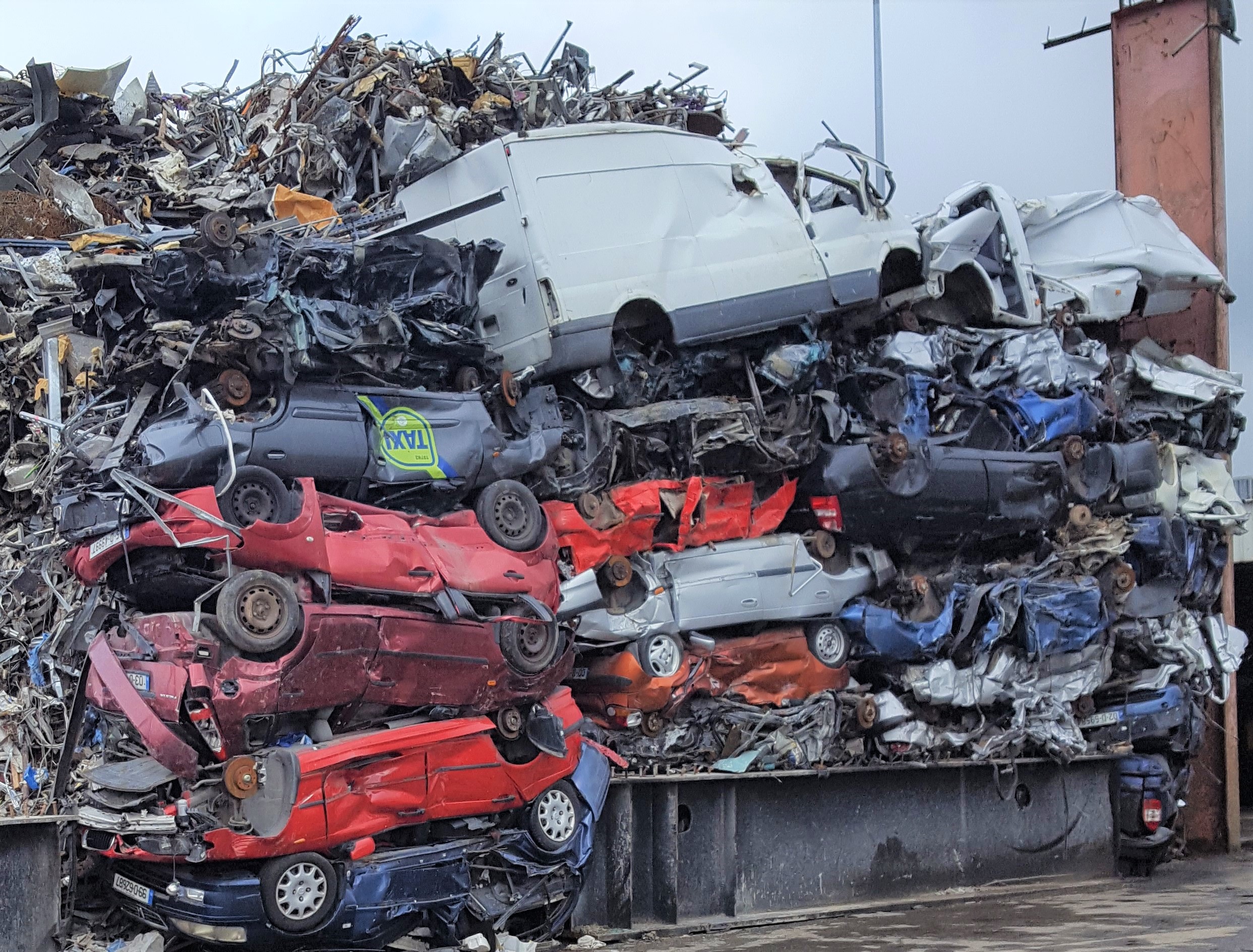End-of-life vehicle statistics for Ireland
EPA waste data release June 2024. Latest reference year 2022. Data subject to Eurostat validation.
Key trends
An estimated 105,494 ELVs (scrap vehicles) were treated in Ireland in 2022, equating to an estimated 111,824 tonnes of waste (see Table 1).
- This was a decrease of approximately 27.6% on 2021 when 118,867 ELVs were treated.
The latest EPA data show that Ireland continued to meet all reuse and recycling rate targets for end-of-life vehicles in 2022.
- Ireland achieved a reuse and recycling rate of 88.47% compared with the EU target of 85%
- Ireland achieved a reuse and recovery rate of 95.49% compared with the EU target of 95%.
- In 2022, there was a decrease in ELV arisings in Ireland. This may be linked to the decrease in the sale of new vehicles.
| Treatment Type | Tonnes | Percentage % |
|---|---|---|
| Reuse & Recycling | 98,934 | 88.47 |
| Reuse & Recovery | 106,775 | 95.49 |
| Disposal | 5,049 | 4.51 |
| Total | 111,824 | 100 |
Ireland achieved an End-of-Life Vehicle (ELV) reuse and recycling rate of 88.47% and a reuse and recovery rate of 95.49% in 2022, in compliance with current EU targets.
This is the fifth year that Ireland achieved full compliance with the ELV Directive targets which were fully met for the first time in 2018 (see Figure 1 & Table 2).
Ireland must continue to improve the reuse, recycling, and recovery of valuable material from end-of-life vehicles as part of our transition to a circular economy
-
Table 2 - ELV Reuse, Recycling, Recovery rates 2010-2022
Reference Year 2010 2011 2012 2013 2014 2015 2016 2017 2018 2019 2020 2021 2022 ELV reuse and recycling % 77 81 82 80 82 83.30 86.00 85.90 86.37 87.43 90.33 87.81 88.47 ELV reuse and recovery % 77 83 88 92 91 91.80 92.80 94.60 95.17 95.21 97.12 95.74 95.49 Open in Excel: Table 2 Recovery rates 2010-2022 (XLS 10KB)
-
Table 3 - End-of-life vehicles arising in Ireland from 2012-2022
reference year: 2012 2013 2014 2015 2016 2017 2018 2019 2020 2021 2022 total tonnage ELV arising 105339 98015 92208 79405 104105 149235 172273 158412 126000 154365 111823.77 total number of ELVs arising (#) 102073 92467 86950 74910 98213 140788 162521 149445 118867 145628 105494.12 Open in Excel: Table 3 ELVs arising from 2012 to 2022 (XLS 8KB)
What are End-of-Life Vehicles?
ELVs are cars or light commercial vehicles (weighing less than 3.5 tonnes) that are no longer suitable for use and are discarded as waste.
ELVs generate between 8 and 9 million tonnes of waste in the European Union (EU) annually. The EU ELV Directive (2000/53/EC) sets out measures to promote the reuse, recycling and recovery of ELVs and requires each Member State to meet the targets of 95% reuse and recovery of ELVs, with a minimum of 85% reuse and recycling.
Why do we need to recycle End-of-Life Vehicles?

You are required by law to have your end-of-life vehicle deposited at a vehicle recycler that is permitted by the local authorities or licensed by the EPA. Vehicle recycling facilities or ATFs are better known as ‘scrapyards’ or ‘car dismantlers’. These facilities will accept your vehicle free of charge but there might be a fee for collection.
If ELVs are not recycled, the European economy loses millions of tonnes of valuable materials such as metals that can be reused, recycled and recovered as part of the circular economy.
Find out more about how to recycle your end-of-life vehicle and the location of your nearest vehicle recycler through your local authority or at elves.ie or mywaste.ie.
ELV treatment process
When a vehicle is no longer suitable for use, it should be brought to a vehicle recycling facility (ATF). The ATF will then issue the registered owner with a Certificate of Destruction so they will no longer be liable for motor tax.
The first step of the ELV treatment process is depollution. This process involves the removal of hazardous materials such as oils, fuel, fluids, batteries, air conditioning fluids / gases and explosive components (e.g. air bags) from the ELV. The ELV may also be dismantled to obtain spare parts for reuse and components for recycling. Commonly removed spare parts include mirrors, lights and engine parts. Tyres and catalytic converters are generally removed for recycling.
In the next step of the treatment process, the depolluted ELV is shredded at a metal recycling facility. The shredded ELV material is then segregated into ferrous and non-ferrous metal and non-metal material.
The shredded metal is melted to make new metal products. The non-metallic shredded material undergoes further treatment.
ELV producer compliance scheme
All of the economic operators involved in the life cycle of vehicles, including vehicle manufacturers, distributors and importers have obligations to meet the ELV Directive reuse, recycling and recovery targets.
The ELV Directive aims to prevent & limit waste from end of life vehicles and improve the environmental performance of all economic operators involved in the life-cycle of vehicles.
Ireland's producer compliance scheme for ELVs, ELV Environmental Services (ELVES), was established in 2017. It works on behalf of vehicle manufacturers, distributors and importers to improve the ELV processing in Ireland and enable its member to meet their regulatory responsibilities. ELVES also promote a network of ATFs to encourage vehicle owners to recycle ELVs at permitted ATFs.
ELV data collection
The EPA uses information provided by ATFs through the National Waste Collection Permit Office (NWCPO) and other waste facilities, to gather data on ELV collection and processing. This data is supplemented by information from the Society of the Irish Motor Industry (SIMI), ELVES and the Department of Transport.
Ireland achieved an End-of-Life Vehicle (ELV) reuse and recycling rate of 87.81% and a reuse and recovery rate of 95.74% in 2021, in compliance with current EU targets.
This is the fourth year that Ireland achieved full compliance with the ELV Directive targets which were fully met for the first time in 2018 (see Figure 1 & Table 2).
Ireland must continue to improve the reuse, recycling, and recovery of valuable material from end-of-life vehicles as part of our transition to a circular economy.
European reporting
As part of annual reporting under the End-of-Life Vehicles Directive, the EPA submits ELV waste statistics for Ireland to the Department of Environment, Climate and Communications for transmission to Eurostat, the statistical office of the European Union. The data are required to be submitted by 30th June of the reference year +2 (i.e. 2022 data were collected and processed in 2024 were due to be submitted to Eurostat by 30th June 2024). Following validation by Eurostat, official statistics for Ireland and all Member States are published on the Eurostat website as part of the following datasets:
- End-of-life vehicles by waste operations - detailed data:
https://ec.europa.eu/eurostat/databrowser/view/ENV_WASELV/default/table?lang=en
- End-of-life vehicles: Reuse, Recycling and Recovery, totals:
https://ec.europa.eu/eurostat/databrowser/view/ENV_WASELVT/default/table?lang=en

Download Infographic on ELVs
To see data from previous years see: End-of-Live Vehicles Data Archive | Environmental Protection Agency (epa.ie)
